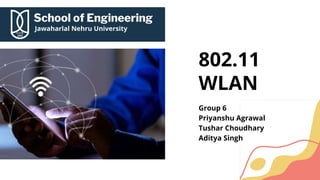
802.11 Computer Networks
- 1. 802.11 WLAN Group 6 Priyanshu Agrawal Tushar Choudhary Aditya Singh
- 4. TYPES OF ARCHITECTURE 1. AD HOC NETWORK 2. INFRASTRUCTURE NETWORK
- 5. Ad Hoc Network • This mode is a collection of computers that are associated so that they can directly send frames to each other. • There is no access point.
- 6. Infrastructure Network • Each client is associated with an Access Point that is in turn connected to the other network. • The client sends and receives its packets via the AP. WHAT IS ACCESS POINT ?
- 7. Protocols
- 8. Data Link Layer MAC Sublayer In 802.11, the MAC (Medium Access Control) sublayer determines how the channel is allocated, that is, who gets to transmit next. Logical Link Layer Above it is the LLC (Logical Link Control) sublayer, whose job it is to hide the differences between the different 802 variants and make them indistinguishable as far as the network layer is concerned.
- 10. Microwave Oven Garage Door Openers Cordless Phones Baby Monitors 802.11 Physical Layer Radio Spectrum 2.4 GHz 5 GHz ISM
- 11. 802.11 Physical Layer 802.11b • upto 11 Mbps • Similar to CDMA • 2.4 GHz • Barker sequence is the spreading sequence used.
- 12. 802.11 Physical Layer 802.11a • upto 54 Mbps • OFDM (Orthogonal Frequency Division Multiplexing) • 5 GHz • Formed first but was approved later than 802.11b.
- 13. 802.11 Physical Layer 802.11 g • upto 54 Mbps • OFDM (Orthogonal Frequency Division Multiplexing) • 2.4 GHz
- 14. 802.11 Physical Layer 802.11n • upto 600 Mbps • OFDM (Orthogonal Frequency Division Multiplexing) • 2.4 GHz and 5 GHz • MIMO (Multiple Input Multiple Output) • Doubled channels from 20MHz to 40 MHz
- 15. 802.11 Physical Layer 802.11ac • upto 6.8 Gbps • OFDM (Orthogonal Frequency Division Multiplexing) • 5 GHz • Downlink MU-MIMO (Multi User - Multiple Input Multiple Output)
- 16. • upto 10 Gbps • OFDMA (Orthogonal frequency-division multiple access) • 2.4 GHz and 5 GHz • Downlink and Uplink MU-MIMO (Multi User - Multiple Input Multiple Output) 802.11 Physical Layer 802.11ax
- 18. • IEEE 802.11 defines two MAC sublayers: 1) Distributed coordination function (DCF) 2) Point coordination function (PCF) • 802.11 tries to avoid collisions with a protocol called CSMA/CA (CSMA with Collision Avoidance). • This mode of operation is called DCF (Distributed Coordination Function) because each station acts independently, without any kind of central control.
- 19. • Initially before sending station senses whether channel is free or not. • Otherwise, the station chooses a random backoff value using binary exponential backoff. • When the counter reaches zero the station transmits the entire frame and then waits for an acknowledgment. • If an acknowledgment is received, the transmitting station knows that its frame has been correctly received at the destination station. • If the acknowledgment isn’t received, the transmitting station reenters the backoff phase in step 2, with the random value chosen from a larger interval.
- 20. • PCF (Point Coordination Function) in which the access point controls all activity in its cell, just like a cellular base station. However, PCF is not used in practice because there is normally no way to prevent stations in another nearby network from transmitting competing traffic. • There are two main reasons why 802.11 MAC does not implement collision detection: ⚬ Station must be able to send data and receive collision signals at the same time. ⚬ Hidden terminal problem
- 21. • From the perspective of node 1, node 2 is a "hidden" node. If a simple transmit-and-pray protocol was used, it would be easy for node 1 and node 3 to transmit simultaneously, thus rendering AP unable to make sense of anything. • An optional RTS/CTS mechanism uses the NAV to prevent terminals from sending frames at the same time as hidden terminals. Hidden Terminal Problem Img source:
- 22. • The network allocation vector is a virtual carrier-sensing mechanism used with wireless network. • While RTS/CTS sounds good in theory, it is one of those designs that has proved to be of little value in practice. • CSMA/CA with physical and virtual sensing is the core of the 802.11 protocol.
- 30. • Association • Re association • Dissociation • Authentication • Distribution • Integration • Data Delivery • Privacy • QOS traffic scheduling • Transmit power control • Dynamic Frequency Selection 802.11 Services
- 31. Future Prospects & Conclusion • IEEE 802.11ax™, or Wi-Fi 6, is the most recent standard in the series, published in 2021. • Next to take center stage will be Wi-Fi 7. • Wi-Fi 7 is based on features defined in the IEEE P802.11be™ draft amendment. • The evolution of IEEE 802.11-based Wi-Fi standards continues today, providing much faster data transmission rates, longer ranges, and more reliable and secure connections.
- 32. References • 802.11 Wireles Networks The Definitive Guide; Matthew S. Gast; ISBN:0-596-00183-5 • Tanenbaum, Andrew S., 1944-Computer networks / Andrew S. Tanenbaum, David J. Wetherall. ISBN-13: 978-0-13-212695-3 (alk. paper) • Computer networking: a top-down approach / James F. Kurose, University of Massachusetts, Amherst, Keith W. Ross, NYU and NYU Shanghai. ISBN 9780133594140 • Forouzan, Behrouz A. Data communications and networking I Behrouz A Forouzan. ISBN 978-0-07-296775-3
- 33. Thank You
Editor's Notes
- 1.7.2013
- 1.7.2013
- 1.7.2013
- 1.7.2013
- 1.7.2013
- 1.7.2013
- 1.7.2013
- 1.7.2013
- 1.7.2013
- 1.7.2013
- 1.7.2013
- 1.7.2013
- 1.7.2013
- 1.7.2013
- 1.7.2013
- 1.7.2013
- 1.7.2013
- 1.7.2013
- 1.7.2013
- 1.7.2013
- 1.7.2013